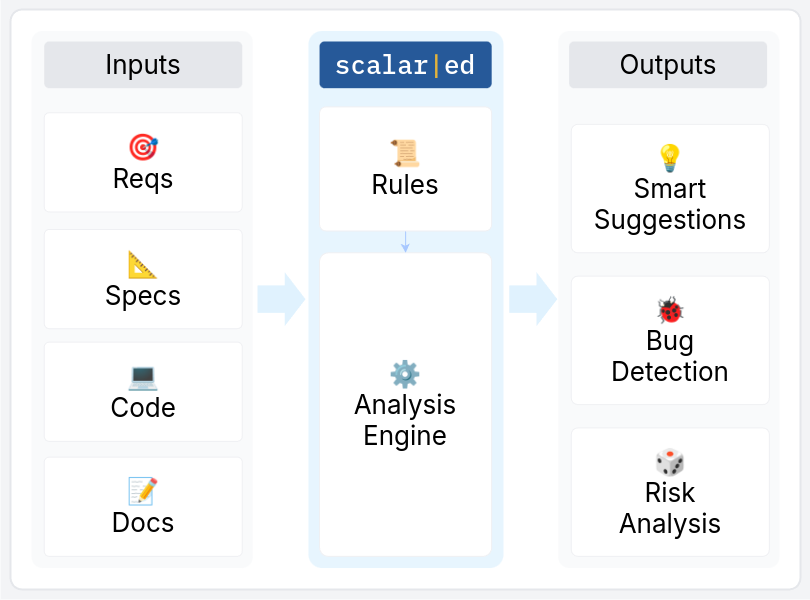How Scalared Works
Understand how Scalared analyzes your design artifacts to provide insights, catch bugs, and accelerate hardware development.
Scalared helps digital design and verification teams stay aligned, reduce risk, and move faster—by analyzing the artifacts they already produce.
We unify specifications, RTL, testbenches, and documentation into a single, intelligent system. From there, our engine evaluates consistency, coverage, and clarity—surfacing actionable feedback when it matters most.

Inputs We Analyze
Scalared begins by ingesting the core artifacts of your hardware development process:
- Requirements: Natural language or structured design intent.
- Specifications: Block-level or system-level spec documents, written in plaintext, Markdown, or Word files.
- RTL: SystemVerilog and Verilog codebases.
- Testbenches: UVM environments and test scenarios.
- Documentation: Inline comments, architectural notes, or onboarding guides.
Each input is parsed, linked, and mapped against the others, enabling rich, contextual understanding.
What Our Engine Does
Once data is collected, Scalared runs a series of analysis passes:
- Consistency Checks: Verifies that RTL behavior matches documented specifications and requirements.
- Completeness Reviews: Flags missing signals, testbench gaps, or untested conditions.
- Best Practice Audits: Applies a customizable guideline database to promote clean, maintainable code.
- Natural Language Linking: Connects comments, specs, and tests with underlying RTL logic to detect mismatches.
- Historical Trend Analysis (optional): Tracks design progress, regression history, and recurring risk areas.
What You Get
From this deep analysis, Scalared generates:
- Smart Suggestions: Specific, contextual tips to improve quality, coverage, or clarity.
- Bug Reports: Clear, traceable issues based on cross-domain inconsistencies.
- Progress Reports: Snapshots of design readiness, including coverage and spec alignment.
- Risk Analysis: Heatmaps of fragile, under-tested, or misunderstood modules.
- Onboarding Summaries: Clear maps of design intent for new team members.
Easy Integration
Scalared is designed to work with your existing setup:
- Git-based workflows
- Text-based documents (Markdown, plaintext, reStructuredText)
- Common formats for SystemVerilog/UVM
- API and command-line interface (CLI)
You choose what data to provide—and Scalared gives you visibility, quality control, and insights without requiring disruptive process changes.
Why It Matters
Scalared doesn’t replace your engineers—it supercharges them.
By capturing institutional knowledge, spotting hidden risks, and reinforcing good habits, we help teams:
- Onboard faster
- Review smarter
- Ship with confidence
Whether you’re building PCIe PHYs or ML accelerators, Scalared helps you go from guesswork to great design.
Ready to learn more? Contact us or request a demo.